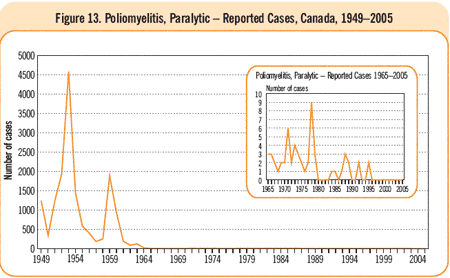Common menu bar links
Institutional links
Diseases & Conditions
Health & Safety
Research & Statistics
Agency Information
Search Box
E-mail this page
Vaccine-Preventable Diseases
Poliomyelitis
Poliomyelitis is a disease that may cause irreversible paralysis in less than 1% of infected individuals. It is a highly infectious disease caused by three serotypes of poliovirus. It is spread from person to person principally through the fecal-oral route. The virus is extremely stable and can remain viable in the environment for long periods of time. Following the introduction of inactivated poliovirus vaccines (IPV) in Canada in 1955 and of trivalent oral poliovirus vaccine (OPV) in 1962, indigenously acquired disease has been eliminated (see Figure 13).
Epidemiology
In Canada
Canada was certified polio-free in 1994. The last major Canadian epidemic of wild poliovirus occurred in 1959, with 1,887 paralytic cases reported. Smaller clusters occurred after that time. In 1978-79, there were 11 paralytic cases among unimmunized individuals in religious groups in Ontario, Alberta and British Columbia, who had contact with imported cases. In 1993, 22 asymptomatic persons with imported wild polio infection were found in the same religious group in Alberta, and in 1996 an asymptomatic person was reported in Ontario. In none of these instances was spread of the virus seen outside the unimmunized groups, presumably because of high levels of immunization in the rest of the population, nor did cases of clinical illness occur in the affected communities in Canada.
More recent cases of paralytic poliomyelitis in Canada have been associated with OPV use. Eleven of 12 paralytic cases in Canada reported between 1980 and 1995 were vaccine associated paralytic poliomyelitis (VAPP). Eight occurred in the contacts of vaccinated persons (three confirmed and five possible), and one was a confirmed vaccine recipient. The remaining two cases were not reviewed but occurred in known contacts of OPV-vaccinated children. Vaccine programs in Canada switched from OPV to IPV in 1995/1996; the last VAPP case occurred in 1995.
In 1985, the Pan American Health Organization (PAHO) adopted a goal of elimination of poliomyelitis from the Americas, and this goal was achieved in 1994. To ensure that Canada remains polio-free, the Public Health Agency of Canada reviews surveillance data for acute flaccid paralysis (AFP) collected by the Immunization Monitoring Program ACTive (IMPACT) system and the Canadian Paediatric Surveillance Program (CPSP), operated by the Canadian Paediatric Society. From 1996 to 2004, between 30 and 63 cases of AFP in children < 15 years of age were reported to the CPSP each year, none attributed to wild or vaccine-derived poliovirus.
The global polio eradication initiative
The World Health Organization (WHO) initially established a goal for the global eradication of polio by 2000. This was amended to 2005 and subsequently to 2008, because polio cases continued to occur in south Asia and west/central Africa. The temporary suspension of OPV vaccination in northern Nigeria in 2003-04 resulted in an outbreak that spread to 14 previously polio-free countries, and wild poliovirus transmission was re-established in six previously polio-free countries. In 2005, three out of six WHO regions have achieved polio eradication: the Americas, the Western Pacific and the European regions.
The WHO's eradication strategy for 2004-08 consists of the following steps: (a) interrupting poliovirus transmission in 2004-05 by increasing OPV coverage in epidemic areas using national immunization days and "mop-up" campaigns, (b) ensuring that there is access to WHO-accredited laboratories for AFP surveillance, (c) achieving certification of global polio eradication in all regions by 2006-08, (d) cessation of OPV use by 2006-08 to prevent circulation of vaccine-derived poliovirus, and (e) ensuring that all regions conduct proper laboratory containment of wild and vaccine-derived polioviruses.
To manage unforeseen outbreaks, WHO may develop a stockpile of the current trivalent OPV or monovalent OPV (mOPV) for each of the three serotypes of poliovirus. The advantage of mOPV is that it would induce mucosal immunity to the specific outbreak strain and would not result in the ongoing circulation of the remaining two vaccine strains in the community. However, mOPV is not available in North America. The alternative is to establish an adequate supply of IPV to vaccinate susceptible individuals.
Source: Canadian Immunization Guide, 7th edition, 2006
Links to more information
Guidelines and Recommendations
- For information about Poliomyelitis vaccine, see the Canadian Immunization Guide, 7th edition 2006
Information Sheets
Travel Medicine Program

